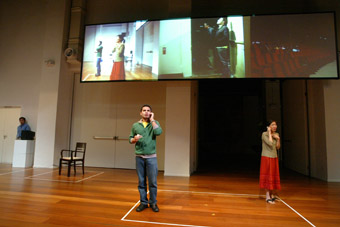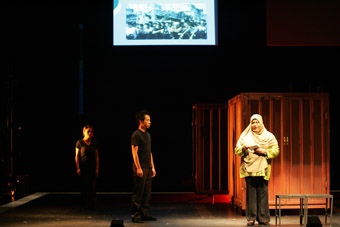When worlds converge
Sarah Miller on visions local, regional & global in Singapore

Play on Earth
Play on Earth
Whilst 4 days isn’t nearly long enough to come to grips with this small island republic of 4 million, on first impressions Singapore is an exhilarating mix of people and cultures, high and low-rise, heritage and contemporary architectures. Mandarin, Malay, English and Tamil are the official languages, and ‘Singlish’ I’m delighted to say, is alive and well, lah. And then there’s the food! Singapore is rightly famous for its fantastic mix of flavours. Given that Perth has a strong connection to both Singapore and Malaysia, I still can’t believe that this was my first exposure to Peranakan cuisine, a Malay Chinese hybrid. On the other hand it has to be admitted that the world is divided into those who adore the durian fruit and those who do not; I have discovered that I definitely fall into the latter category.
I was in Singapore with journalists from Thailand, the Philippines, New Zealand and Australia to experience a few days of the Singapore Arts Festival, to learn about the arts and arts infrastructure in Singapore and experience some of the city’s urban revitalisation. For a decade Singapore has dedicated itself to becoming a distinctive global city for the arts, and to making the arts integral to peoples’ lives. Perhaps it’s the compact nature of this island state, not to mention the passion and enthusiasm of local artists, art professionals and bureaucrats, but there is no doubt that the arts in Singapore are flourishing with initiatives that range from secure accommodation for artists and companies, including the fabulous refurbishment of the National Museum of Singapore, to programs of support for artists and companies, and an international outlook and focus. It was great to visit the National Museum of Singapore, which reopens in December following a comprehensive renovation. Spaces are being opened to the public in a carefully staged program of events, both as a means of road-testing the new spaces as they come online as well as promoting the new facilities. Our tour of the building allowed us to experience the international touring exhibition, The Scenic Eye: Visual Arts and the Theatre, curated by Wolfgang Storch. Inspired by René Block and his connections to Fluxus, the exhibition invited a range of artists including Rosemarie Trockel and Thomas Schütte and sound designer Hans Peter Kuhn, to create works that reflect on theatre through installation, sculpture, photography, drawing and interactives.
Festival hardware
The Singapore Arts Festival is certainly the nation’s premier arts event but it sits alongside an ongoing range of programs supporting local artists and companies, and other special events including the Writers Festival and the inaugural Singapore Biennale in September. So if the hardware (buildings) are not only functional but also stylish, I’m delighted to say that the software—to extend the metaphor—is complex, richly textured, quite tough in terms of content and formally sophisticated. The festival itself is extremely comfortable in positioning local art and artists within a regional and international context.
It was quite extraordinary to experience the standard of housing offered to artists and companies, not to mention the calibre of performing arts centres ranging from the purpose-built: the Esplanades—Theatres on the Bay and the recently relocated Drama Centre in the National Library Centre, for instance, to the incredible restorations of heritage buildings such as TheatreWorks’ new home 72-13 and The Arts House. The latter was originally built as a private home in 1827, becoming Singapore’s first Courthouse, then Parliament House before re-opening as a multidisciplinary arts and heritage centre in 2004. While much has been written of the Esplanade Theatre with its acoustically perfect concert hall and outstanding opera theatre, other venues similarly reflect a concern for the highest standards of presentation and great working conditions for artists. Our tour of the new Drama Centre was a case in point. It holds a 615-seat proscenium arch theatre and an intimate black box space with a seating capacity of 120. Equipped with state of the art lighting, rigging and sound systems, the seating is comfortable and the acoustics excellent. I know, because I had the great pleasure of seeing The Necessary Stage’s Mobile there.

Mobile
Mobile
Co-directed by Alvin Tan and Tatsuo Kaneshita with Haresh Sharma as head writer, Mobile is a unique collaboration involving artists from Thailand, Singapore, the Philippines and Japan. This was fantastically provocative, utterly relevant theatre, which illuminated the power dynamics of migrant, often unskilled labour—Thai sex workers and Philippino maids for instance, as well as Buddhist monks and Japanese businessmen—in a global market place. The creative process began more than a year ago and involved 4 playwrights from each of the countries working with Haresh Sharma and the script developed through extensive fieldwork. In Japan, interviews were conducted with various NGOs, activists and academics involved with foreign workers. In Thailand, the creative team visited women’s shelters in Chiang Mai and conducted interviews in Bangkok with NGOs involved in the protection of sex workers and their rights. In Singapore the creative team interviewed migrant workers from various organizations. Mobile has thus been an international collaboration of some complexity and has evolved into a political and intercultural theatre of wit, empathy and intelligence that extends the company’s ongoing fascination with the contemporary realities of what they have described as “multiple Asias.”
Not all aspects of Mobile were equally successful. The play’s framing device of 2 women delegates at an NGO conference had some hilarious moments, but was cartoonish compared to the emotionally complex interior scenes, and the closing scene was disappointing. On the other hand, the ‘play within a play’ portraying migrant workers at an NGO’s conference, was hysterically funny (reminding me of Australian Chris Lilley’s outrageous mockumentary, We can be heroes). What distinguishes this work is the generosity of the exchange between forms and cultures predicated on openness to the potential for change. This richly theatrical provocation moved beyond simplistic notions of accountability and blame into a much more complex space where the tragic and the comic are reframed within the everyday experiences of mobility, labour, social disparity and discrimination. I hope it tours to Australia.
Play on Earth
In late 2005, TheatreWorks moved into the recently renovated 72-13, a converted rice warehouse. This beautiful space—light, airy and modern—is flexible enough to function as a gallery, a cinema and a theatre and could happily inhabit the pages of Wallpaper. So it was fantastic to experience the conceptually and formally ambitious theatrical experiment, Play on Earth, by Station House Opera (UK) in collaboration with TheatreWorks (Singapore), Philharmonia Brasileira (Brazil) and Newcastle Gateshead Initiative (UK) at 72-13. Projected live from 3 corners of the world onto screens above the actors, a narrative unfolds that is immediate yet remote, familiar but unpredictable, alive but discontinuous. The narrative is not really the point but there is a story of sorts tracing the strange and discontinuous nature of relationships across time and place. I was mesmerised by the play between the live (immediate) and live (remote) performances, even when it was something as apparently naff as passing flowers from one continent to another or waving cheerily at audience members on the other side of the globe, but then I’ve always been a sucker for a good trick. This was a remarkably ambitious experiment to be programmed within an international performing arts festival and testifies to the sophistication of the Singapore Arts Festival.
Hotel Modern, The Great War
Another highly imaginative and politically resonant work was the Netherlands-based Hotel Modern’s The Great War. In this production, the audience witnesses in miniature the reconstruction of the landscapes of the Western Front of 1914-18 laid out on tables using sawdust, potting soil, rusty nails and parsley for trees. Rain falls from a small handheld sprinkler; an aerosol jet firebombs cardboard towns; a peaceful field gradually mutates into a sea of toxic mud. Inside a fish tank, ships are bombed by torpedoes and sink; flotsam and bodies bob to the surface. The performers, using digital and mini cameras film and edit live through a vision mixer, which is simultaneously projected onto a large screen. The results are larger than life, and staggeringly and shockingly real.
Composer, Arthur Sauer, brings the narrative to life with an outstanding live soundtrack created by using contact microphones, distortion and amplification. A knock on a table for instance sounds like a grenade on impact; the striking of a match like escaping mustard gas, while a vibrator run over a small tin of marbles sounds chillingly like tanks. The performers constantly construct and reconstruct the experiences of war before our eyes. This live animation is also accompanied by readings drawn primarily from eyewitness accounts, as well as from found letters sent home, written by a French soldier to his mother during a long stay in the trenches. A descriptive excerpt from All Quiet on the Western Front is also used. These readings are replete with the small daily practical issues, intimate details and personal experiences of men in the trenches, lending the production an incredible poignancy and reminding us of the utter waste, horror and stupidity of war.
Compagnie Marie Chouinard
The openness to collaboration and experimentation, the humanity and poignancy of Mobile, Play on Earth and The Great War exposed the potential limitations of a purely formal approach. Canadian Compagnie Marie Chouinard’s bODY_rEMIX/gOLDBERG_variations was a physically rigorous and virtuosic work, utilising—as its title suggests—an interpretation of Bach’s Goldberg Variations as performed by Glen Gould, remixed by composer Louis Dufort. The remix included vocal samplings of Glen Gould speaking in a 1981 radio interview and the resulting composition distorts into something menacing and strange. This somewhat literal approach was reflected by the movement vocabulary. Bodies are distorted, extended and remixed through various prosthetics including crutches—often shortened or attached unicorn-like to the forehead or other equally unexpected body parts—as well as ballet barres, ropes and harnesses. The dancers were further handicapped, often wearing only one pointe shoe with one bare foot, the other often worn on the hand, so that their performances were inherently off balance. Moving sometimes on 2 limbs and sometimes on 4, crouching, rearing, liberated and fettered, they appeared like strange cloven-hoofed creatures, some new hybrid brought into being through arbitrary acts of cruelty.
Ballet barres turn into the appendages of a struggling duo. Crutches protrude unexpectedly, turning movement into something alien but always dancerly. Often, the dancers perform en pointe creating perverse shapes and exploring an inventive gestural language. Nevertheless at 100 minutes (including interval) I found myself getting increasingly restless. The after-show discussion confirmed that this was a formal experiment exploring ‘constraint and freedom’ that sought no reference points beyond its own polished amalgam of crafted capabilities.
Local, regional, global
The theme of this year’s Singapore Arts Festival, “One Season: Many Faces”, was reflected in a growing list of co-productions and a commitment to a form of internationalism that is distinctly Asian and which celebrates the local. Festival Director Goh Ching Lee’s commitment to supporting artists in the making of their work is palpable. With such an outstanding program, it will be interesting to see what Singapore’s inaugural Biennale of Visual Arts delivers. Having adopted the conceptual framework of ‘Belief’, the curatorial team led by Fumio Nanjo, the high profile Deputy Director of Tokyo’s Mori Art Museum, have assembled a rich and varied selection of artists to exhibit. The Biennale, like the Singapore Arts Festival, is sure to be both self aware and sophisticated, political but not didactic and to embrace the local as well as the regional and the international.
Sarah Miller thanks her hosts, the National Arts Council and the Singapore Tourism Board for their generous hospitality. She also thanks Real Time’s Managing Editor for sending her in his stead.
Singapore Arts Festival, June 1-25, www.singaporeartsfest.com
RealTime issue #74 Aug-Sept 2006 pg. 36-






